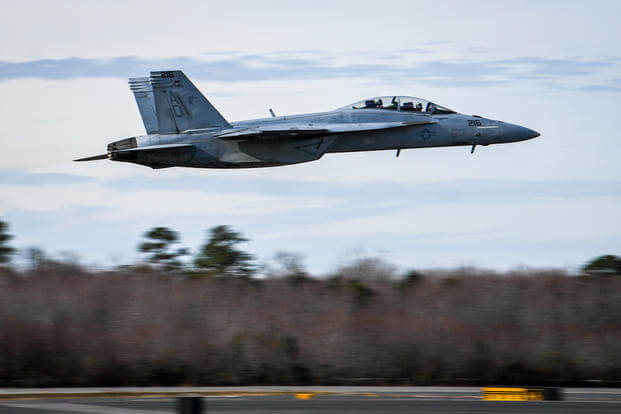A Navy F/A-18F Super Hornet sustained engine damage earlier this month from a bird strike during a routine flight.
The pilot and weapons systems officer were unharmed and were able to land the two-seater jet following the March 22 mishap, said Lt. Cmdr. Robert Myers, public affairs officer for Naval Air Force Atlantic.
The F/A-18, from Strike Fighter Squadron (VFA) 106, out of Naval Air Station Oceana, Virginia, was conducting a low flight near Naval Air Facility El Centro, California, according to a Naval Safety Center report.
Read Next: NORAD Tracks 2 Russian Spy Planes That Entered the Alaskan Air Defense Zone
The aircraft, on a detachment to the West Coast, landed safely at El Centro, Myers said.
The report said the starboard intake engine was damaged from the bird strike, or the collision between birds and aircraft, and has been labeled a Class A mishap. That's the most severe mishap classification, indicating damage of at least $2.5 million or the loss of an aircraft.
“We are viewing this as a Class ‘A’ mishap, however, an investigation will determine both the cause of the incident and the level of damage sustained,” Myers said in an email Wednesday.
Officials this week downgraded another mishap involving a fighter from Class A to Class C, meaning damage sustained totaled between $60,000 and $600,000.
The mishap involved an F-35B Joint Strike Fighter, capable of short takeoff and vertical landings.
The stealth jet, attached to VMX-1, the Marines' Yuma-based test and evaluation squadron, was conducting a nighttime close air support mission on March 12 on the Yuma Range Complex when a PGU-32/U Semi-Armor Piercing High Explosive Incendiary-Tracer (SAPHEI-T) 25mm round exploded after leaving the fighter's cannon.
The exploded round caused damage to the fighter's fuselage, according to the Naval Safety Center. It was not immediately clear if the round was fired deliberately.
-- Oriana Pawlyk can be reached at oriana.pawlyk@military.com. Follow her on Twitter at @Oriana0214.
Related: Marine Corps F-35B in Arizona Damaged by Round Discharged from Jet Cannon












